How bionics could inspire landscape architects?
DOI:
https://doi.org/10.15584/pjsd.2016.20.13Keywords:
bionics, landscape architecture, sustainable development, biodiversityAbstract
Bionics is an interdisciplinary science investigating the structure of organisms, the ways they function and the possibility to adopt these solutions in engineering (particularly in automation), and to model the structure of technological systems on such organisms. It is used in numerous engineering designs (aircraft, parachute, photovoltaic solar cells). Watching the tricks of nature is highly enlightening and useful. The study discusses the mission of landscape architects, and provides examples of adaptations based on natural solutions; it also involved designing survey questions designed to assess opinions of students of landscape architecture regarding the need to promote sustainable development and biological diversity and to copy solutions observed in nature. It was also emphasized that in order to maintain stability of the existing ecosystems friendly to human beings it is necessary to follow the example of nature and reduce the waste of resources and energy, and to widely accept the upcoming era of scarcity.
Downloads
References
Gerland P., Raftery A.E., Ševčíková H., Li N., Gu D., Spoorenberg T., Alkema L., Fosdick B.K., Chunn J., Lalic N., Bay G., Buettner T., Heilig G.K., Wilmoth J. 2014. World population stabilization unlikely this century. Science. 17. s. 49-55. DOI: 10.1126/science.1257469.
Łepko Z. 2012. W sprawie techniki dla zrównoważonego rozwoju. Studia Ecologiae et Bioethicae. 10. 1. 9-27.
Katowicz-Kowalewski H. 2012. Technika architektonicznego kamuflażu w pracach projektantów miejskich krajobrazów trzeciego tysiąclecia. Zeszyty Naukowe Politechniki Częstochowskiej. Budownictwo. 167. 18. 50-61.
Kostecka J. 2009. Przestrzeń przyrodnicza jako wartość dla zrównoważonego rozwoju. Zesz. Nauk. Poł.-Wsch. Oddziału PTIE i PTG w Rzeszowie. 11. 135-140.
Kostecka J., Mazur-Pączka A., Jasińska T., Batóg K. 2013. Pojęcie „świadczenia ekosystemowe” i jego rola w edukacji dla zrównoważonego rozwoju (na przykładzie bzu czarnego Sambucus nigra L.). Inżynieria i Ochrona Środowiska. 15(4). 405-417.
Kostecka J., Kostecki A. 2014. Retardacja wykorzystywania i kreowania ekosystemów w terenie zurbanizowanym. Biuletyn KPZK PAN. 254. 85-112.
Kucharczyk M. 2011. Inkluzywizm a społeczna odpowiedzialność architekta. Architektura Czasopismo Techniczne. 108. 16. 17-127.
Millenium Ecosystem Assessment. 2005. Ecosystems and Human Well-being: Biodiversity Synthesis. World Resource Institute. Washington. DC. s. 1-86.
Patoczka P. 2012. Pojęcia stosowane w architekturze krajobrazu. Teka Kom. Arch. Urb. Stud. Krajobr.-OLPAN. VIII. 1. 116-123.
Patoczka P. 2016. Linie nieba. Wydawnictwo Uniwersytetu Rzeszowskiego.
Remmert H. 1985. Ekologia. Państwowe Wyd. Rolnicze i Leśne. Warszawa.
Rogers R.1997.Cities for a Small Planet. London. Faber and Faber. 153.
Samek A. 2010. Bionika. Wiedza przyrodnicza dla inżynierów. Wydawnictwo AGH. ss. 485.
Świątek L. 2012. Bio-City. Reintegracja ekosystemów miast. Architektura Czasopismo Techniczne. 109. 1. 243-247.
United Nations Department of Economic and Social Affairs. 2014 revision of the World Urbanization Prospects [Źródło: http://www.un.org/en/development/desa/publications/2014-revision-world-urbanization-prospects.html][data wejścia 24.05.2016].
Wehle-Strzelecka S. 2011. Relacje architektury i przyrody - wkład twórców modernizmu. (w:) Modernizm w Europie. Modernizm w Gdyni. Architektura pierwszej połowy XX wieku i jej ochrona w Gdyni i w Europie. [red.] Maria Jolanta Sołtysik, Robert Hirsch. Gdynia: Urząd Miasta Gdyni. 151-156.
Wołek I. 2012. Pałace na piasku. Dubaj- Zjednoczone Emiraty Arabskie. W: Dookoła świata z Ireneuszem Wołkiem. Kurier Powiatowy. 5. (97). 20-21.
Rozporządzenie Ministra Pracy i Polityki Socjalnej z dnia 20 kwietnia 1995 r. w sprawie klasyfikacji zawodów i specjalności dla potrzeb rynku pracy oraz zakresu jej stosowania [Dz.U.1995.48.253]
Downloads
Published
Issue
Section
License
Copyright (c) 2016 Polish Journal for Sustainable Development

This work is licensed under a Creative Commons Attribution-NonCommercial-NoDerivatives 4.0 International License.


